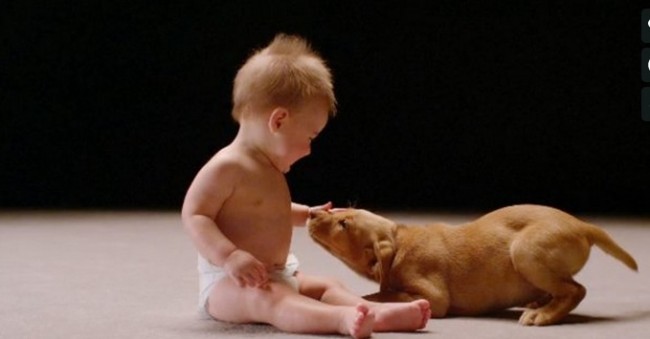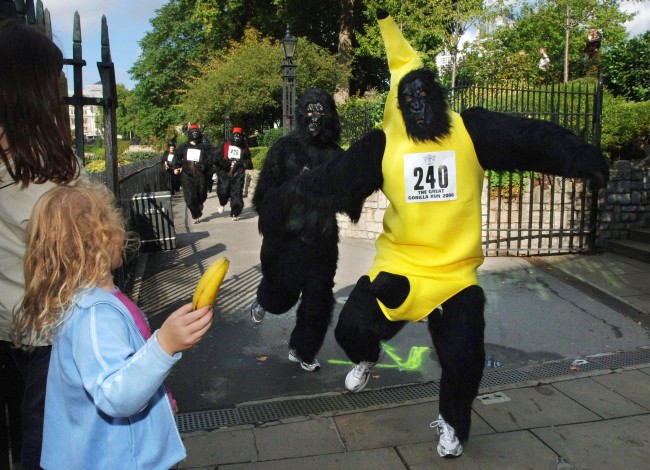Key Posts Category
1940s Pre-Code Comic Book Horrors And Dr Wertham’s 1954 Seduction of the Innocent
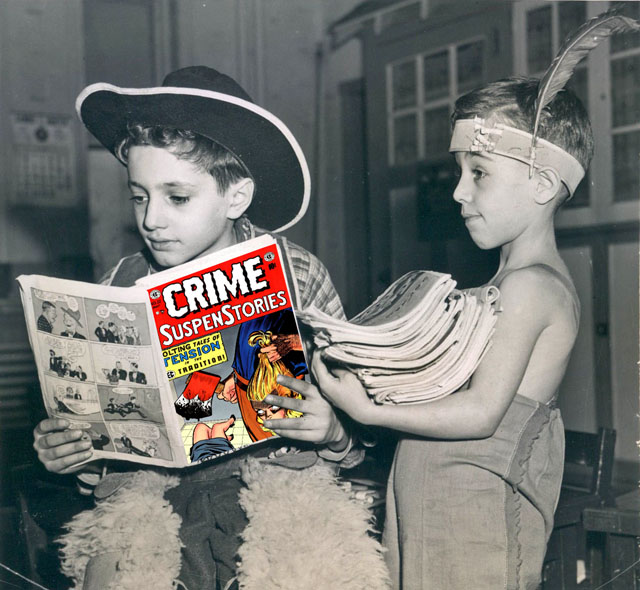
“There is no such thing as a moral or an immoral book. Books are well written or badly written.”
– Oscar Wilde
Dr. Wertham’s 1954 book, Seduction of the Innocent, was an American bestseller – it tapped into the fears of parents from sea to shining sea and led to the a frenzy of censorship in the comic book world. The irony, however, is that the book was so poorly researched, that much of its content was simply made up. Of course, the public didn’t give a baker’s f**k about facts, and Seduction of the Innocent became a sensation.
Read the rest of this entry »
Posted: 29th, June 2014 | In: Books, Flashback, Key Posts | Comments (2)
Adrian… er, Adrian Chiles…uh…gives…. er, gives… uh… pause for… uh…thought

PAUSE for thought?
Hello… and… uh… welcome to… er….welcome to… uh… this… uh… article… in which we, er…. will be… uh… touching… on… an issue which… er, which is… uh… becoming increasingly prevalent in… the…uh… in the… broadcast… media.
Listen to Radio 4’s Today or PM flagship current affairs programmes and you will hear the mellifluous Scottish tones of two presenters in an increasingly intensive competition to break the world record for dead air by the simple expedient of… pausing… between… almost every… other… word.
But this phenomenon is nothing to do with uncertainty, or nervousness, or an inability to string two words together. These are assured, experienced, eloquent, senior journalists.
So why do they do it?
Read the rest of this entry »
Posted: 28th, June 2014 | In: Celebrities, Key Posts, TV & Radio | Comment
Guilty Pleasures: 5 Musicians Of The 70s You’re Supposed To Hate (But Secretly Love)
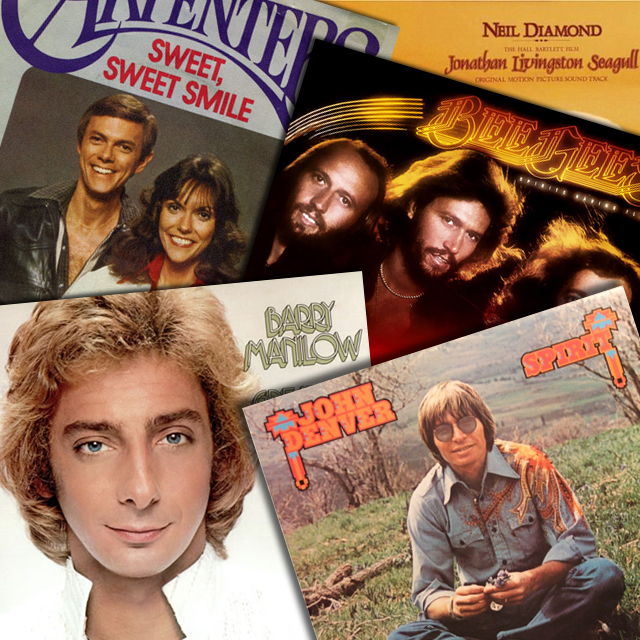
1. The Carpenters
Everyone remembers that scene in Tommy Boy where Farley and Spade declare their distaste for The Carpenters. After all, The Carpenters are “lame”. Only the biggest loser would actually like The Carpenters.
Fast forward a bit, and they’re singing their little hearts out to “Superstar”….
The fact is, The Carpenters are awesome. I’ll admit it. I’ll also admit to 4 others… but don’t let me stand alone. Join me in pronouncing once-and-for-all that it’s “okay” to love these artists. Don’t carry these secrets with you any longer. Shout it from the rooftops. Your soul shall be cleansed.
2. Barry Manilow
In similar fashion to Tommy Boy, there’s a scene of sweet release in Family Guy. After a news report on Barry Manilow airs, the gang at the bar vigorously denounces the singer, but can’t contain their shameful secret for long. Within moments, all four giddily come out of the Manilow closet…
They end up drifting into Manilow’s “Ready to Take a Chance Again”, as well they should. Manilow rules.
3. John Denver
I remember when the Silver Fox (Charlie Rich) protested John Denver’s award at the CMA’s by literally lighting the ballot on fire on live television.
The incident made Rich look like a drunken douchebag, but the damage had been done; Denver had been publicly denounced. He wasn’t accepted in the country genre, and he definitely had no friends in the rock world. Denver’s cool points equaled zero.
Yet, all this derision was unfounded. Denver wrote about the Earth and an appreciation for the natural world better than anyone. While most bands of the Seventies were singing about f***ing, Denver was singing about the inner peace one only can find deep in the woods.
Sure, he didn’t look as cool as Ritchie Blackmoore twirling his guitar or Robert Plant thrusting his junk every which way… but must we always have the twirling and the thrusting? Sometimes it’s okay to just take the rock theatrics down a peg, and just stand there and sing your songs.
4. Bee Gees
I think we may have reached a point in our society where it’s okay to admit to liking the Bee Gees. However, for a couple decades after the fall of disco, you didn’t dare. In fact, Barry Gibb had to literally go undercover to write his music. You didn’t know Kenny Rogers (“Islands in the Stream”) or Dionne Warwick (“Heartbreaker”) were singing Gibb tunes, but they were. The Bee Gees were, frankly, too reviled to dare release these songs.
But, damn, Barry effing OWNED the late Seventies…
Starting in 1976, when Gibb discovered his flair for the falsetto on “Nights on Broadway” it was off to the motherf***ing races. He gave a few gems to his brother Andy (“I Just Want to Be Your Everything”) then the trio released “Jive Talking” and a string of hits that would continue unabated until 1980. The Gibb’s made the Billboard charts their bitch for about 4 straight years.
Barry was a hitmaker for everyone: With Streisand (“Guilty”), Samantha Sang (“Emotion”), Yvonne Elliman (“If I Can’t Have You”), Frankie Valli (The theme song for Grease) and Andy (“(Our Love) Don’t Throw It All Away”, “Shadow Dancing”, and “(Love Is) Thicker Than Water”).
Add in the hits he recorded with the Bee Gees, and it’s truly astounding. In 1978, the Bee Gees owned 5 of the US Top 10 (a chart dominance not seen since The Beatles in ’64), and Barry became the only person to ever record 4 consecutive US number one hits.
Then came the disco backlash and the Brothers Gibb were the prime casualties. True, their massive Sgt. Pepper fail didn’t do them any favors, but the venom they received was undeserved. They were the poster boys of disco, and disco was considered an embarrassment for many years to come.
Well, I say “no longer”.
5. Neil Diamond
Poor Neil has never been cool. But like Manilow, he had a following in the 70s almost exclusively consisting of white thirtysomething females, which certainly didn’t add to his street cred. Wear a Neil Diamond concert shirt to school, and expect to be punched repeatedly in the nuts. Schoolmates didn’t take kindly to public expressions of Diamond fandom.
Diamond’s early hits were respectable enough “I’m a Believer” and “A Little Bit Me, A Little Bit You” became hits for the Monkees, and Diamond followed them up with count’em 10 number one hits in the US. “Cracklin’ Rosie”, “Cherry, Cherry”, “Sweet Caroline”, “Song Sung Blue”, “Red Red Wine” and “Solitary Man” are all stellar.
The problem is, Diamond jumped the shark. Somewhere along the way, he started dressing like Liberace and attracting hordes of housewives to his concerts. A cheesy duet with Streisand (“You Don’t Bring Me Flowers”) followed up by the cheesiest song ever recorded, “America” just made matters worse. Then the nail in the coffin: the song inspired by the movie, E.T. There was simply no going back….
Good God, that is awful. But just as Vegas Elvis shouldn’t cloud our memory of early Elvis, I won’t let Sequined Jacket Wearing Diamond cloud his early work. I will wear my Neil Diamond concert tee with pride. Viva la Diamond!
Posted: 27th, June 2014 | In: Flashback, Key Posts, Music | Comment (1)
Mic Wright’s Remotely Furious: The Weird World of Meet the Mormons
WATCHING Meet The Mormons (Channel 4) felt like taking part in a bizarre game of Where’s Wally? as the camera caught glimpses of the Church PR people lurking just out of shot. There are 200,000 Mormons in the UK and the elders at the church’s Salt Lake City HQ seemed to think giving director Lynn Alleway access to a young British missionary could up that number. But for viewers whose knowledge of the sect stretched no further than Osmonds, this hour-long look at 20-year-old Josh from Sussex beginning his two years mandatory missionary work was far from edifying.
A representative from the Church was always just out of shot and often creeping into view as Alleway worried that the young man was struggling to cope with his challenge. We saw him in tears early on before resigning himself to the constant attention of his mentor, a Swiss missionary named Elder Bauman who was not much older than him but far steelier in his determination to knock on every door in Leeds and remain upbeat despite the constant knock-backs.
Read the rest of this entry »
Posted: 27th, June 2014 | In: Key Posts, TV & Radio | Comment (1)
Killer Nazi Child-Eating Rats Take Over Britain: The tale Of The Daily Star’s Toothy Shockers
THE Country is in fear of “Monster Rats As Big As Cows”.

Cows are pretty big.
Read the rest of this entry »
Posted: 27th, June 2014 | In: Key Posts, Reviews, Tabloids | Comment
The 5 Greatest Episodes of Buck Rogers in the 25th Century (1979 – 1981)
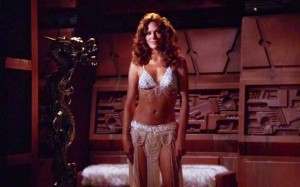
AS impossible as it is for me to believe, Glen Larson’s version of Buck Rogers in the 25th Century (1979 – 1981) turns thirty-five years old this year.
Today, this cult-TV series is often remembered for its spandex fashions, its gorgeous female stars and guest stars, its penis-headed robot Twiki (Felix Silla/Mel Blanc), and its oppressive re-use of familiar or “stock” visual effects in the space dogfights.
Though Buck Rogers in the 25th Century had its weak installments, for certain (like the dreadful “Space Rockers”) it was also a light science fiction series — a romp, essentially — and the series is recalled fondly by fans on those terms too.
Read the rest of this entry »
Posted: 26th, June 2014 | In: Flashback, Key Posts, TV & Radio | Comments (2)
Drive the Chicks Wild! Vintage Menswear Adverts
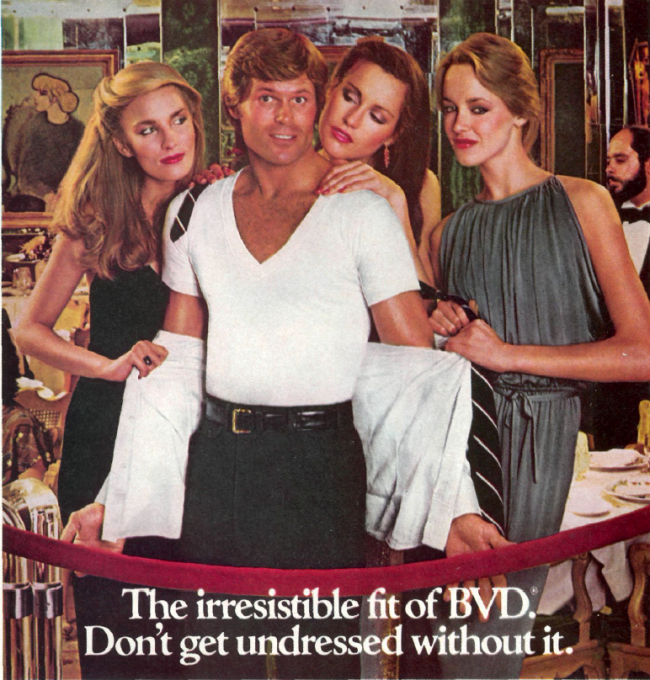
THE obvious way to sell men’s clothing is to proclaim that the garments will somehow turn the average guy into an irresistible Studasaurous. From the late Sixties to early Eighties, when Baby Boomers were in their sexual prime, this marketing tactic went into hyperdrive. Boomers were ready to mate, and menswear adverts proclaimed that their apparel was the gateway to sweet, sweet lovemaking. Here are a few examples.
Read the rest of this entry »
Posted: 26th, June 2014 | In: Fashion, Flashback, Key Posts | Comment (1)
Is Rock And Roll Dead? No. It Just Smells Bad
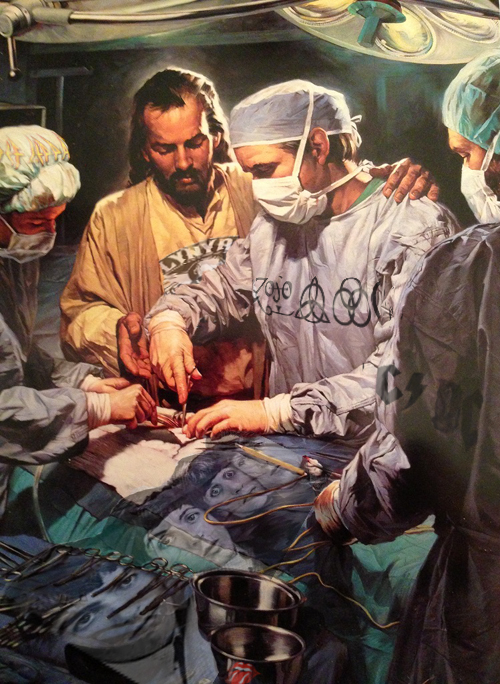
“ROCK and Roll isn’t dead. It just smells bad.”
I am, of course, paraphrasing Frank Zappa’s famous response when asked whether jazz was dead. Who would have guessed that quote would be applicable to rock music just a few decades later.
There are many of you already feeling your blood pressure rise at what I’m saying. I can hear you now: “There are tons of great bands today! All you have to do is stop wallowing in the past you old bastard, and dig for it!” Problem is – if you have to dig it up, it’s probably dead.
Read the rest of this entry »
Posted: 25th, June 2014 | In: Key Posts, Music | Comments (13)
10 Reasons Aerobics In The 1980s Was Crazy Awesome
BY THE 1980s, the Baby Boomers, who had enjoyed the Sexual Revolution as trim youth, suddenly found themselves with a little extra weight as they entered their thirties. The alarm was sounded, and what followed can only be described as a cocaine-fueled mania. One manifestation of this fitness assault was an aerobics explosion. I don’t think anyone really knew what they were doing, but they looked wonderfully insane doing it.
1. AEROBICELEBS

Kathy Lee Crosby and Markie Post
Of course, this whole maniacal phenomenon would’ve never gotten off the ground were it not for the necessary endorsement from celebs. Jane Fonda made a mint off her workout video, but other famous names were only too quick to jump on the new trend.
Read the rest of this entry »
Posted: 23rd, June 2014 | In: Fashion, Flashback, Key Posts, The Consumer | Comment (1)
‘The Same Animals…Only Functioning Less Perfectly:’ The Five Most Underrated George A. Romero Movies
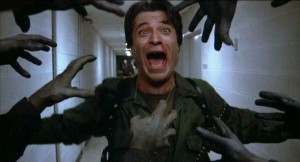
GEORGE Romero’s impressive movie-making career stretches back to the Pittsburgh area in the late 1960s and spans over forty years.
Like many horror filmmakers of his generation, Romero has seen his share of big successes, like Dawn of the Dead (1978) and Creepshow (1982), critical darlings like Martin (1976), cult classics such as The Crazies (1973) and the occasional out-right bomb, like Diary of the Dead (2007).
But several of Romero’s finer films didn’t meet with financial or critical success, and deserve to have further light shone on them. Accordingly, my selections for the most underrated of his feature films are listed below.

Hungry Wives (1971)
George Romero’s self-described “feminist” horror movie, also known as Jack’s Wife and Season of the Witch, involves a bored suburban house-wife, Joan Mitchell (Jan White) who is only able to define herself in terms of her place in the suburbs as a married woman and a home-maker.
In an attempt to rebel against her “accepted” role in society, Joan delves into witchcraft and then adultery, but the movie’s crafty point is, commendably, that witchcraft is no more defining or self-actualizing for Joan than being a house-wife had been. She has merely changed her demographic affiliation or club, while everything else in her life remains the same
Hungry Wives is so powerfully-wrought because George Romero serves as both editor and director, and his editing flights-of-fancy make the movie’s point plain in terms of visualizations. Early on, for instance, Joan experiences a telling dream in which her husband leads her around on a leash, like a dog. One of the film’s final images reveals Joan involved in a coven ritual, a red rope looped about her neck, and the symbolism is plain: she has merely traded one trap for another. This visual counterpoint is underlined by the counsel of Joan’s therapist, who advises her that she is imprisoning herself, and must change that pattern if she hopes to make her life better.
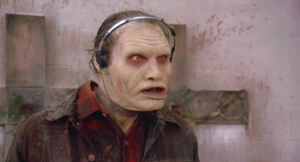
Day of the Dead (1985)
Before 2007 at least, Day of the Dead (1985) was the least-appreciated of the famous Romero living Dead cycle. This lack of approbation was a result, in part,of the film’s overtly and relentlessly serious tone. For all its mayhem and violence, Dawn of the Dead — set at a shopping mall — also had a fun or jaunty side to it. But Day of the Dead proved a totally different animal: a solemn and extremely gory exploration of mankind’s last chapter as the dominant species on Earth.
Rather unconventionally, the movie ends with a committed and likable protagonist, Sarah (Lori Cardille) realizing it is all over but the crying, and essentially giving up the fight so as to live her last years (and the last years of humanity…) on a nice island beach somewhere with two decadent helicopter pilots.
But importantly, Day of the Dead also moves the cycle forward in significant fashion via its introduction of Bub (Howard Sherman), a zombie who has been domesticated, after a fashion, and reveals both rudimentary memory, and rudimentary humanity.
In fact, this lovable zombie shows more humanity than the film’s brutal military leader, Rhodes (Joe Pilato), and thereby suggests that the change in the social order might not be all that bad, if the zombies continue to evolve towards something…civilized.
Finally, Day of the Dead features an epic and awe-inspiring opening,:a view of a city in Florida completely overrun by the living dead. This moment is arguably the biggest in scope of the entire dead run, and establishes brilliantly the zombies’ numerical advantage. As this shot reveals, Day of the Dead is actually the Twilight of Man.
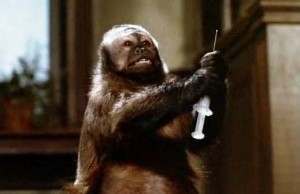
Monkey Shines (1988)
I still remember discussing this Romero horror film at length with visiting movie critic Molly Haskell at the University of Richmond in the late 1980s. We agreed that the critical community had virtually ignored what was a very powerful and very relevant film about human nature.
Monkey Shines involves a man, Allan (Jason Beghe) who is paralyzed in an accident and becomes a quadriplegic. As such, he is provided by his scientist friend (John Pankow) a capuchin monkey named Ella to act as his arms and legs. Before long, Ella and Allan form a close bond of friendship and dependence…but then each begins acting on each other’s emotional states and desires. Soon bloody murder is being committed…but is it at Ellas behest, or Allan’s?
Monkey Shines informs audiences that the “devil” is “animal instinct,” which acts by its “own set of laws,” and then asks the pertinent question: are we that different from the lower animals we treat as pets? Are we truly evolved, or — underneath the surface — are we just as violent and capricious as cousins in the jungle?
The scenes involving Ella in Monkey Shines are convincing and powerful, save for a few moments where an inert stand-in is clearly utilized, and the film’s debate about instinct (an avatar for the human subconscious in some critical way…) makes the film stand out in an era when rubber reality and slasher movies reigned supreme.
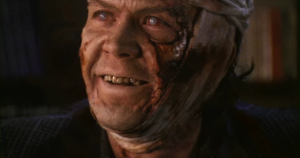
The Dark Half (1993)
Here’s a Stephen King adaptation that almost nobody loves, or even remembers. In The Dark Half (1993) Timothy Hutton plays Thad Beaumont, a writer grappling with his famous nom du plum, George Stark. When Beaumont elects to kill his famous literary name, however, the alter ego comes to life and threatens the writer and his entire family.
A deliberate and modernJekyll-Hyde story, The Dark Half is part of an early 1990s “meta” or post-modern movement in horror. Films such as Wes Craven’s New Nightmare (1994) and John Carpenter’s In The Mouth of Madness (1994) gazed at worlds in which the line between fiction and reality were blurred. The Dark Half treads meaningfully in similar territory, and gazes at the act of writing as literally a physical birth, as an independent creation that – much like a human child – can no longer be fully controlled by its creator.
There’s nothing flashy or expensive about The Dark Half, and the ending is a bit of a bust, but otherwise Romero crafts a thoughtful, low-key horror film that possesses some electric jolts. One early scene, set in an operating room is downright terrifying, and another — with a woman broaching an invader in her dark apartment — also gets the blood flowing.
More than anything, however, The Dark Half explores the idea that the creative act of writing represents a violent assertion of will. “The only way to do it is to do it,” one character notes, and this same determination indeed is what wills the Dark George Stark into the world.

Survival of the Dead (2009)
Survival of the Dead is yet another Romero living dead movie, and another seriously underrated work of art. Since the very beginning of his career in 1968, director Romero has used his zombie saga to explore political and social issues of the time.
For example, Night of the Living Dead speaks to the political violence and upheaval of 1968, and to race relations in America. Dawn of the Dead very much concerns conspicuous consumption and the “Crisis in Confidence” Carter Age. And Land of the Dead (2005) explores post 9/11 territory.
Similarly, Survival of the Dead is a thoughtful, point-for-point allegory for American involvement in the Iraq War. Unfortunately, horror movie fans were too busy complaining about CGI blood effects to notice the movie’s clever thematic framework.
In short, Survival of the Dead involves a refugee, O’Flynn (Kenneth Welsh) — the fictional equivalent of Ahmed Chalabi — who tricks American armed forces into fighting his war for him, and ousting his enemy, Muldoon (Richard Fitzpatrick) — a Saddam Hussein figure – from the land that he would like to lead, paradise-like Plum Island.
Obligingly the National Guard moves in — guns blazing — only to find that matters aren’t so straight-forward. The soldiers have become involved in a pissing match that, ultimately, doesn’t concern them or their well-being.
The film features an Old West sort of milieu on Plum Island, with rivals O’Flynn and Muldoon (Richard Fitzpatrick) wearing cowboy hats and riding horses while zombies (here called Dead-Heads) are trapped in the nearby corral.
Again, Romero’s thoughtful set-up makes it impossible not to think of the post-911 “dead or alive” rhetoric from the Bush White House. The film’s final imagery — which depicts cowboy zombie versions of O’Flynn and Muldoon trying to kill each other under a bright moon — makes one despair that human nature is ever going to change.
With neo-con dead-enders everywhere on cable news stations this week attempting to re-enlist America in the war in Iraq a decade later, Survival of the Dead is more relevant than ever. Accordingly, this Romero film is really about discredited zombie ideologies that have long outlived their usefulness, but which keep coming back from the dead to threaten the rest of us.
Posted: 20th, June 2014 | In: Film, Flashback, Key Posts | Comment
The 20 Greatest Codas In Popular Music: The Song Goes From Average To Anthem
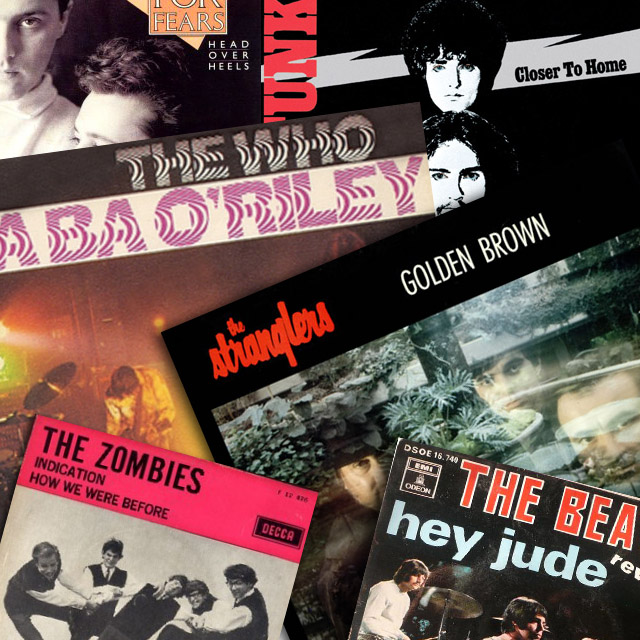
SONGS are composed of various different structures: the chorus, verse, bridge, etc. If they’re put together right, it sounds like one cohesive unit. Today, we’re looking at one section in particular – that last piece, the coda. It’s basically a separate section which brings an end to a song. In popular music, it’s sometimes referred to as an “outro”; the opposite of an intro.
It’s not necessarily long- for instance, “cold outros” as in “What I Like About You” by the Romantics end abruptly (and are a DJ’s worst nightmare). I’m speaking more of the “fade-out coda.” The most well-known example in popular music is probably the “Na Na Na” ending of “Hey Jude”.
Read the rest of this entry »
Posted: 17th, June 2014 | In: Key Posts, Music | Comments (4)
The Sinking Sun: Today The Royal Mail Put Shit Through 22 Million Letter Boxes

NORMALLY if someone puts shit through your letterbox, that person is in breach of the law and could face prosecutions.
Yet today 22 million homes had a piece of shit on the doormat, delivered courtesy of the Royal Mail.
Postal workers refused to deliver said item in Liverpool, in deference to local sensibilities, but the rest of England was not so fortunate.
‘FREE HISTORIC EDITION’ announces the front page: ‘THIS IS OUR ENGLAND’.
And this, ladies and gentlemen, is The Sun 2.0 2014.
Read the rest of this entry »
Pear Shaped: Everything You Needed To Know About Alan Yentob And BBC Arts In One Epic Vine
PRESENTING BBC man Alan Yentob being amazed by Ray Davies’ listed pear tree.
Spotter: Andy Dawson @profanityswan
Posted: 12th, June 2014 | In: Celebrities, Key Posts, TV & Radio | Comment
How England were cheated out of TWELVE World Cups
HOW England were cheated out of TWELVE World Cups.

See that lone star above the Three Lions crest?
Read the rest of this entry »
Posted: 12th, June 2014 | In: Flashback, Key Posts | Comment
Horror TV Boom: The 5 Best X-Files Knock-offs From The 1990s

CHRIS Carter’s landmark TV series The X-Files (1993 – 2002) proved not only a ratings blockbuster throughout the 1990s, but a cultural phenomenon too…the Star Trek of the Clinton Age, essentially. The series, which starred David Duchovny and Gillian Anderson proved so popular that its success led to movies, comic-books, toys, and even spin-offs such as The Lone Gunmen (2001). Chris Carter even had the opportunity to create another masterpiece for the era: Millennium (1996 – 1999).
But importantly, The X-Files also dramatically proved to network executives that horror and science fiction could play well on television if presented intelligently, and with a strong sense of continuity.
Accordingly, the years between 1995 and 1999 saw a veritable flood — a genuine boom — of horror-themed genre programming hit the airwaves.
These series had titles such as American Gothic (1995 – 1996), Strange Luck (1995 – 1996) , Dark Skies (1996), Kindred: The Embraced (1996), Poltergeist: The Legacy (1996 – 1999), Psi-Factor: Chronicles of the Paranormal (1996 – 1999), The Burning Zone (1996 – 1997), Sleepwalkers (1997), Prey (1998), Brimstone (1998 – 1999) and Strange World (1999).
Most of the series above lasted only a season, but nearly all of them involved, like The X-Files, aspects of the police procedural format, and elements of the horror genre, namely the supernatural or paranormal. Many of the series also involved government conspiracies, or an “Establishment” attempt to hide some important “truth” from the American populace.
Below are my choices for the five best of this post-X-Files pack.
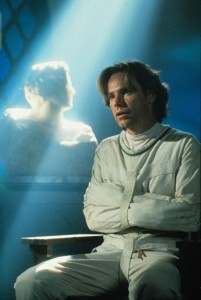
Nowhere Man (1995)
Created by Lawrence Hertzog, Nowhere Man ran for twenty-five hour-long episodes in 1995 and quickly proved a paranoiac’s dream. The series involved Thomas Veil (Bruce Greenwood), a photographer whose very life was “erased” in the premiere episode (“Absolute Zero”) by a shadowy conspiracy.
This act of erasure was undertaken because Veil publicly revealed a top-secret photograph called “Hidden Agenda.” Soon even Veil’s wife, Alyson, (played by Millennium’s Megan Gallagher) claimed not to have any memory of him. She had been “gotten to.”
As the series continued, Thomas began to uncover secrets about the photograph, and about his enemies too, a sinister cabal or conspiracy called “The Organization” (think The Syndicate on The X-Files).
Nowhere Man picks up primarily on The X-Files’ conspiracy vibe, but also features a strong if oblique connection to another TV paranoia trip: The Prisoner (1967). There, the prisoner, Number Six (Patrick McGoohan), was trapped in a bizarre European “village” for spies and ex-spies; but here Veil finds himself in an Information Age trap where the prison is the global village itself.
Nowhere Man is cleverly constructed, right down to the hero’s name — Veil — and so the series’ final episode saw the “veil” over his eyes lifted at last. Today, this series would be ripe for either a movie or TV reboot.
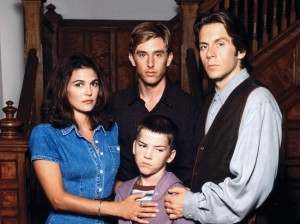
American Gothic (1995)
American Gothic is the tale of Caleb Temple (Lucas Black), a youngster of questionable lineage who lives in the town of Trinity, South Carolina. In the premiere episode, little Caleb sees his father go stark, raving mad, and his sister Merlyn (Sarah Paulson) murdered by the nefarious sheriff, Lucas Buck Gary Cole). Then he learns that not only is Lucas Buck Caleb’s biological father…he may also be the devil.
But before Sheriff Buck can seduce Caleb to the dark side, the sinister force must contend with two most unwelcome “do-gooders” in Trinity: reporter Gail Emory (Paige Turco) and a Yankee upstart with a dark past, Dr. Matt Crower (Jack Weber).
Both carpet-baggers realize Buck is up to no good, and take steps to protect Caleb, but must simultaneously deal with their own personal demons. Gail’s parents died in Trinity twenty years earlier and Lucas Buck just happened to be the person who discovered their bodies. And Matt is still recovering from a drunk-driving incident in which his wife and daughter were killed.
Created by Shaun Cassidy, and produced by Sam Raimi, this soap opera horror owes as much to Twin Peaks (1990 – 1991), perhaps, as it does The X-Files. But all the x-trademarks are present, from a focus on corrupt (or actually evil authority figures…), to storylines which involve police solving crimes in a small-town.
American Gothic succeeds in part because of Gary Cole’s central presence and enormous charisma as the evil sheriff, a figure who can seduce anyone with a smile, and who is even taken, on occasion, to whistling the theme song from The Andy Griffith Show.
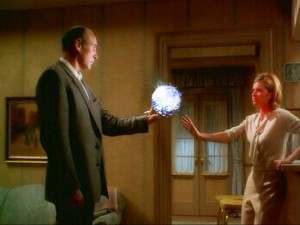
Dark Skies (1996)
Like all the TV series featured on this list, there can be little doubt that NBC’s Dark Skies was granted a prime-time berth because of the success of The X-Files.
There’s also little doubt, however, that Dark Skies is an original, visually-distinctive, and involving program. The one-season series showcases a memorable, growling regular performance from the late J.T. Walsh as the leader of a top-secret alien-hunting organization called Majestic, and features rewarding and intricate plotting across the span of the catalog’s nineteen hour-long shows.
The series is a period piece, interestingly, that concerns alien abduction — one of the key concepts explored in The X-Files.
Dark Skies opens immediately after President Kennedy is inaugurated and the age of Camelot commences. Two young Americans who are filled with enthusiasm — John Loengard (Eric Close) and Kim Sayers (Megan Ward) — go to Washington to serve the country and the new president but quickly become disillusioned when they learn that all is not as it seems. Aliens have infiltrated the highest levels of the American government.
While it’s true that Eric Close looks like he was incubated at a David Duchovny Clone Farm, and that matters of conspiracy in Washington were also heavily featured on The X-Files, Dark Skies nonetheless forges its own unique identity. It does so by replaying key events from human history — the first TV appearance of The Beatles on the Ed Sullivan Show, for instance, or the Kennedy Assassination — through the lens of alien infiltration in human affairs.
That was the “literal” level upon which Dark Skies operated, but the series also, overall, served as a metaphor for politics in the U.S. Naivety and idealism quickly give way to cynicism and dark agendas, and it’s a struggle to know who to trust, and who to believe in.
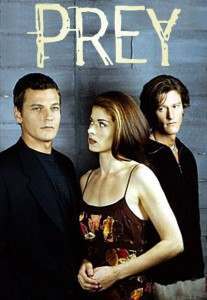
Prey (1998)
The tag-line for the short-lived series Prey on ABC-TV was “We’ve just been bumped down the food chain,” and the series concerned a beautiful geneticist, Sloane Parker (Debra Messing), who learned that a look-alike species — homo dominants — was gaining a foothold on power in North America.
A brilliant scientist not unlike Scully (Gillian Anderson), Sloane came to work with one of the dominants, Tom Daniels (Adam Storke), to help reveal the breadth of the dark conspiracy.
The X-Files often concerned genetic mutants like Victor Eugene Tooms, or other freaks of nature who, in some way could represent one possible future for humanity. Prey likewise involved a similar scenario, but taken to apocalyptic levels. Mankind was losing ground to superior beings, yet those beings were not aliens or monsters…but ones created under the auspices of evolution, by Mother Nature herself. The human race had become outmoded.
So the question became: can man outwit, defeat, and outlive its replacement species?
Over the course of Prey’srun much information was learned about the new species, including the fact that it lacked human emotions but possessed ESP. Prey was also weirdly prophetic. One episode involved school shootings — less than a year before Columbine — and the entire premise seemed to forecast the War on Terror.
In particular, the homo dominants looked and sounded like us, and therefore could imitate humans flawlessly. So your neighbor could actually be a sleeper agent, just waiting for the right moment to strike. In 2004, this was the premise of the re-imagined Battlestar Galactica.
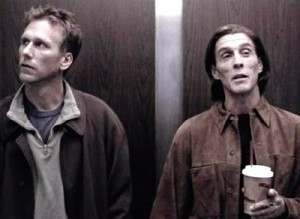
Brimstone (1998 – 1999)
Created by Ethan Reiff and Cyrus Voris, Brimstone aired on Fox as the lead-in to Chris Carter’s Millennium on Friday nights, and ran for just thirteen hour-long episodes before an untimely cancellation.
The series starred Peter Horton as hangdog Detective Ezekiel Stone, a former Manhattan-based police officer who died in 1983…and promptly went to Hell. Stone did so because he took the law into his own hands and murdered his wife’s rapist, Gilbert Jax. Two months after that act of vigilantism, Stone was killed in the line of duty, and he has been trapped in the Underworld ever since.
As the series commences, however, 113 of the “most vile” criminals in Hell manage a jailbreak and return to Earth to wreak havoc. The Devil (John Glover) — trying to cover his ass with the Man Upstairs — recruits Detective Stone to pursue the fugitives and send them back to Hell and permanent incarceration.
Ezekiel can do so only by destroying their eyes, the so-called “windows to their souls.” In exchange for his service, Stone gets a much-valued second shot at human life, happiness, and redemption. Each time Stone kills an escaped convict, a strange runic tattoo (representing the convict’s “number” or identity) burns off his body. Stone must also deal with the fact that some of escaped convicts are extremely powerful, with terrifying supernatural abilities
As the Devil informs the detective: “The longer you’ve been in Hell, the more it becomes a part of you.”
The villains featured on the series reflect The X-Files concept of the “monster of the week.” They are literally twisted creatures from Hell, and the roster includes an unrepentant rapist (“Encore”), a shape-shifter with multiple personalities (“Faces”), a lovelorn poet who kills virgins (“Poem,”) and even a Bonnie and Clyde-styled pair of thugs (“The Lovers.”)
Presented in a kind of de-saturated or silvery-steel color-scheme, Brimstone was another police procedural of the 1990s, like the X-Files, but it proved an original initiative because it worked overtime to diagram a universe of nuanced morality. Despite the presence of God and the Devil in the stories, Brimstone always explored shades of gray, not the least in terms of Stone’s behavior. Did he deserve a second chance? Did he deserve to go to Hell in the first place?
In exploring these issues, Brimstone proved more than your average X-Files knock-off and emerged as a memorable supernatural noir. The series’ sense of humor, revolving around a man from 1983 living at the turn of the century, also proved stellar.
Posted: 12th, June 2014 | In: Flashback, Key Posts, TV & Radio | Comments (4)
8 Reasons Children of the 1970s Should All Be Dead
The way things are going, every kid is going to go to school wearing bubble wrap and a helmet. Back in the 1970s (and earlier), parents didn’t stress about our health and safety as much as they do today. It’s not that they cared less – they just didn’t worry compulsively about it.
Parents of 2014 need to be reminded of how less restricted, less supervised, less obsessively safety-conscious things were… and it was just fine.
1. JARTS: IMPALING ARROWS OF DEATH
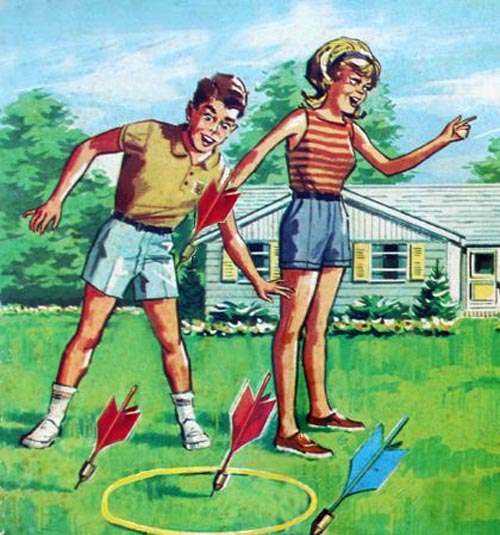
Can your mind comprehend a more deadly toy than a weighted spear that kids hurl through the air like a missile? No one ever obeyed the actual manufacturer’s rules, we just flung these damn things everywhere. We threw them. They stuck where they landed. If they happened to land in your skull, well, then you should have moved.
After roughly 6,700 emergency-room visits and the deaths of three children between 1978 and 1988, they finally outlawed Jarts on December 19, 1988. I suppose it needed to be banned, but a part of me is sad that kids today won’t have the battle scars and Jart survival stories we had. Goodbye Jart – you were an impaling arrow of death, but I loved you anyway.
2. LOST AND NOT FOUND: SEAT BELTS

Cars came with seat belts in the 1970s, but no one used them except maybe out of curiosity to see what it was like to wear one. Of course, you’d have to fish them out of the deep crevice of the backseat cushion where they often came to rest, unwanted and ignored.
The only “click” heard in the 1970s automobile was your dad’s Bic lighting up a smoke with the windows rolled up. (cough!)
I should also mention that, not only were there no seat belts, child seats were nowhere to be found. Whether it was the front seat of your mom’s station wagon or her bicycle, chances are, you were entirely untethered.
3. SEMI-LETHAL PLAYGROUNDS OF HOT METAL

Remember when playgrounds were fun? Sure, there was a pretty good chance you’d be scalded by a hot metal slide, or walk away with tetanus, but that’s what memories are made of.
The ground wasn’t coated with soft recycled rubber or sand as most are today – they were asphalt. Remember being hurled from a spinning merry-go-round, then skidding across the gravel at full speed? Good times.
I remember my school playground had a metal ladder “wall” that I swear went up three stories – it didn’t connect to a slide or anything. It was literally a ladder to the sky. I remember fully believing the oxygen was thinner at the top. One false move and I’d have been a flesh colored stain on the asphalt.
According to the New York Times we are making playgrounds so safe that they actually stunt our kids’ development. So, while blood was spilt and concussions were dealt on the playgrounds of the 1970s, we were at least in a developmentally rich environment – and we had the bruises and scabs to prove it.
4. PRECIOUS LITTLE SUN PROTECTION
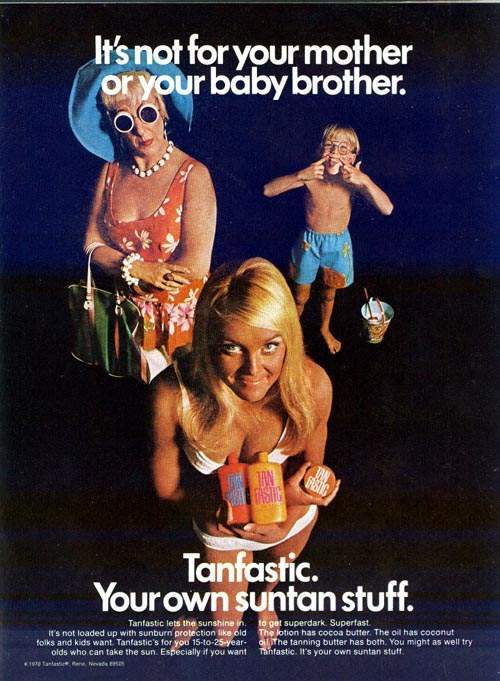
“Tanfastic lets the sunshine in. It’s not loaded up with sunburn protection like old folks and kids want. Tanfastic’s for you 15-to-25 year olds who can take the sun. Especially if you want to get superdark. Superfast.”
Back in the 70s, your goal was to get as brown as your skin would permit. Sun BLOCK or sun SCREEN was basically nonexistent. You wanted to AMPLIFY your rays, so women typically lathered on Crisco and baby oil to get that deep baked look.
For the kids, SPF numbers hovered around 2, 4 and 8. The idea that you would spray an SPF of 50 or even 30 wasn’t even an option, except perhaps from medical ointments prescribed for albinos.
5. HELMETS: FOR THOSE WITH MEDICAL CONDITIONS ONLY
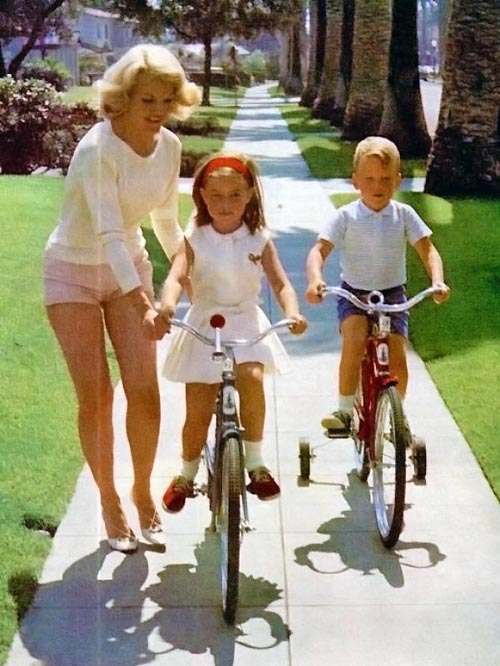
Whether you were riding a bike, roller skating, or skateboarding, one thing was for certain: you were not wearing a head protection. You would have been looked at as a sideshow freak by other kids, and parents would assume you had some kind of medical condition.
6. IGNORED AND UNATTENDED ON THE REGULAR

Hey, who’s watching the kid in the stroller? YOU MUST HAVE YOUR EYES ON THE KID AT ALL TIMES OR ELSE HE WILL DIE!
My mother routinely left me alone in the car at a young age while she ran errands. Today, this will literally get you arrested. You see, once upon a time it was okay to leave your kids for long periods without supervision (remember the so-called “latch-key kids” of the 70s?), or let them free roam without constant surveillance. Today, parents won’t let their kids go out to get the mail alone, and any fun with friends has to be scheduled, closely monitored “play dates”.
On summer break or weekends in the 1970s, parents kicked their kids out the front door and didn’t let them back in until the sun went down. “Go play,” were their only words, and you were left to your own devices for hours upon hours. Neighborhoods looked like Lord of the Flies.
7. ROUTINELY ALLOWED TO GET SERIOUSLY HURT
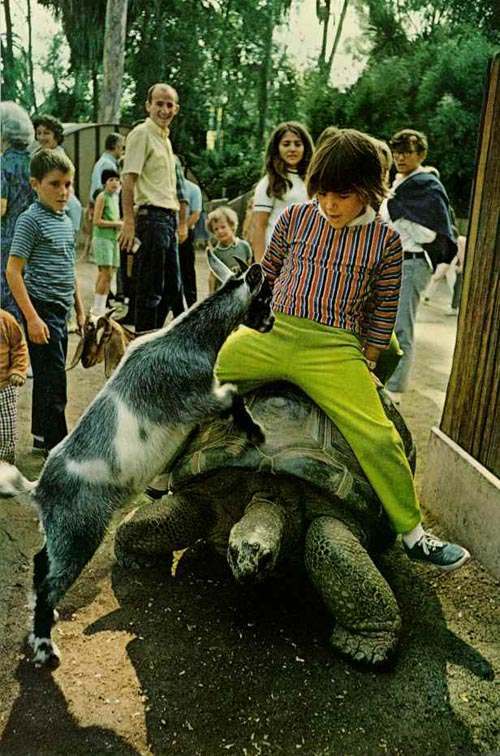
This poor kid is about to get rammed in the nuts by a goat, and the nearby adult isn’t the least bit concerned. In fact, he finds this all incredibly amusing! As hard as this is to believe, but when kids got hurt back then, adults didn’t come running with first-aid kits. More than likely you’d be left alone with your pain, with no alternative but to get over it.
In the 70s, parents watched their offspring fall from trees and fall off bikes with a smile.
8. SECONDHAND SMOKE EVERYWHERE

From airplanes to your family car, it seemed the world of the 70s was shrouded in a haze of cigarette smoke. It wasn’t just the fact that many more people smoked, it was the absolute 100% lack of concern for those that didn’t, including children. Teachers smoked, doctors smoked, your parents smoked…. and they didn’t take it to a secluded smoking area, they did it right in your face.
Please don’t interpret this as condoning it. There’s no question that engulfing your child in a thick carcinogenic cloud isn’t a good idea. I’m just stating facts – this is the world we lived in. It was full of adults who didn’t seem to have anxiety attacks over our safety, and we turned out just fine…. right?
Posted: 9th, June 2014 | In: Flashback, Key Posts, Reviews | Comments (442)
You Don’t Dare Kill It: The 5 Best Alien (1979) Knock-Offs of the 1980s

RIDLEY Scott’s Alien (1979) dramatically altered the template for horror films set in outer space. For example, the blockbuster film was among the first (after Dark Star [1975] to suggest that travel in the final frontier would be the purview of “work-a-day” space truckers rather than noble explorers or adventurous astronauts.
And instead of intrepid space travelers fighting men-in-rubber suits inside idealized white-on-white space station environs (as was the case in The Green Slime [1968]) Alien suggested a technological space age marked by endless industrial corridors and aliens of constantly shifting dimension.
The Scott film’s central alien — a bio-mechanoid horror created by H.R. Giger — could also gestate inside a living human host, and this fact ushered in a new era of cinematic “body horror.”
As with any genre blockbuster, Alien almost immediately spawned a host of knock-offs, some terrible and some quite good. These films found much material to imitate and emulate, from the diverse make-up of Alien’s victim pool, to bloody variations on Alien’s famous chest-burster birth scene. Many Alien knock-off films also involved long forgotten derelicts or other structures on alien planetary surfaces, for instance. Inevitably, human crews would discover these Lovecraftian edifices and wake up age-old horrors.
Among the Alien knock-offs of the 1980s were Scared to Death (1981), Forbidden World (1982), The Beast Within (1982), Parasite (1982), The Being (1983), and Biohazard (1985), to name just a handful.
The list below represents five of the best — or at least the most memorable– of the Alien knock-off breed. As is often the case regarding knock-offs, the best such films are invariably those that re-purpose not merely the clichés from one source – in this case — Alien — but also from other literary or cinematic works as well.

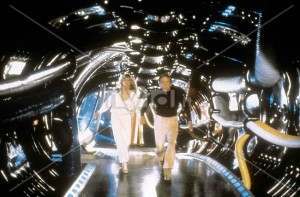
Saturn 3 (1980)
The story of a psychotic mad scientist, Captain Benson (Harvey Keitel) who travels to the Experimental Food Research Station on a moon of Saturn during a twenty-two day eclipse and communications black-out called “Shadow Lock,” the much-reviled Saturn 3 might actually be considered, first-and-foremost, a child of the Frankenstein story.
On remote Saturn 3, Benson assists two scientists working to alleviate a famine on overpopulated planet Earth. Major Adam (Kirk Douglas) and his romantic partner, the beautiful and innocent Alex (Farrah Fawcett) are wary, however, of Benson’s form of help: a colossal humanoid robot named Hector, the first of the “Demi God” series. Hector boasts human intelligence, not to mention human tissue. And echoing his creator’s madness, he soon begins lusting mightily after Alex.
Outside the space-age Frankenstein monster tropes, Saturn 3, like Alien, is set in a location where aid and assistance from the authorities is not available. Similarly, Earth in both films is depicted as a used-up dystopia. In Alien, “the company” controls everything on Earth, and in Saturn 3, humans have polluted the planet and resorted to rampant drug use because of the planet’s inhospitable nature.
Hector stands in for the titular alien, as well, and hunts down the film’s Adam and Eve-styled protagonists in the facility’s twisting factory-like corridors.
Finally, in Scott’s film, the Alien is almost entirely a creature of instinct, driven by impulses to reproduce and survive. In Saturn 3, by contrast, the monster is a machine that experiences something “human” beyond programming: psychosis and lust. Hector is ultimately beaten, however, because as a machine he can’t understand the human concept of self-sacrifice.
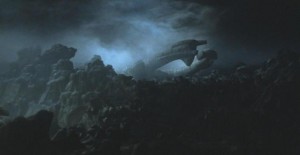
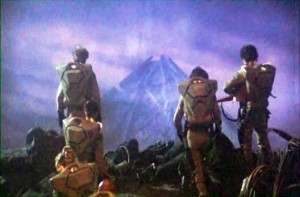
Galaxy of Terror (1981)
Aliens (1986) director James Cameron served as a production designer on this knock-off from Roger Corman’s New World Studios, and in the process created a universe that is very reminiscent of the Scott film, at least from a visual stand-point. Like Alien, Galaxy of Terror is set in a “lived in” universe (unlike, say the white-on-white minimalism of 2001: A Space Odyssey [1968] or Space: 1999 [1975 – 1977].)
In Galaxy of Terror, a rescue ship, The Quest, heads to the mysterious planet called Morganthus to discover the fate of the Remus, another ship which crashed there. Once on the surface of dark Morganthus, however, the Quest crew discovers a strange alien pyramid. Soon, the crew — including characters played by Robert Englund, Sid Haig, Grace Zabriskie, and Erin Moran — begins to experience their worst fears made manifest.
In this case — if the plot summary hasn’t given it away already — Galaxy of Terror draws inspiration not only from Alien, but from Forbidden Planet (1956), a film in which another rescue mission (to Altair-4) runs afoul of a “Monster from the Id,” actually the human subconscious. That’s pretty much the case here, only with slimy monsters, doppelgangers, and a scene involving a rape by a giant alien worm.
The alien pyramid in Galaxy of Terror looks like it could have been constructed on Alien’s LV-426, and the slate gray sky above it even looks eerily similar. More trenchantly, perhaps, Galaxy of Terror’s rape scene also reflects the violent sexuality seen in Alien, the harsh re-purposing of the human body for unwholesome breeding purposes.
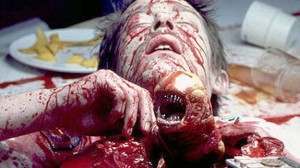
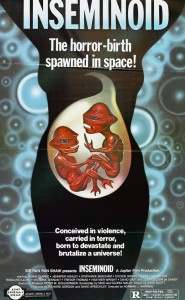
Inseminoid (1982)
Also known as Horror Planet, Inseminoid is probably the schlockiest film on this list. The film stars Judy Geeson, Stephanie Beacham and Victoria Tennant as astronaut scientists, and involves the discovery of an ancient alien tomb on a far distant planet.
Before long, one astronaut, Sandy (Geeson), is impregnated by the last living alien in the tomb, and becomes the protective expectant mother of two ghastly alien twins. Her maternal instinct is re-purposed to serve an interloper’s biological imperative.
And just as Kane in Alien gives birth to the chest-burster, here Geeson gives birth to two monstrous tykes who — naturally — nurse on human blood.
Inseminoid’s central conceit is that everything on this distant alien world is “doubled.” The planet orbits twin stars, and the alien mythology is obsessed with twins, and so forth.
Although lacking tact (especially in the flashbacks to Sandy’s impregnation), Inseminoid occasionally features a beautifully composed shot, such as one on the purple surface of the distant planet during a funeral. There was also a funeral (for Kane) in Alien, but this shot of an alien vista grants the hororr film a nice sense of scope and also a visceral sense of place.
Like Alien, Inseminoid also concerns an alien species that co-opts the human race for its own reproductive requirements. Here, the aliens suckle on the (open) wounds of dead humans, and Sandy herself becomes a bit blood-thirsty as her biology is altered to play host to most unwelcome invaders.
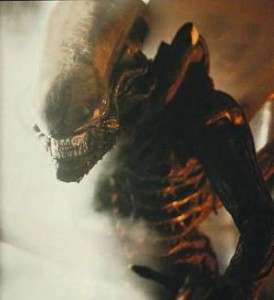
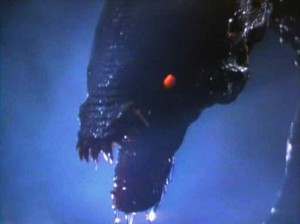
Creature (1985)
A corporate spaceship, the Shenandoah, sets down on Titan to investigate an ancient alien archaeological site. The Shenandoah’s mission is imperiled, however, by the arrival of a ship from a competing corporation, Richter Dynamics, and the presence of its freakazoid captain, played by a scenery-chewing Klaus Kinski.
Before long, the rival crews learn that the archaeological site was actually something akin to an alien zoo or laboratory: a collection of diverse aliens from all over the universe. Unfortunately, one managed to break free from its captivity and is now attacking and brainwashing human beings…
Creature — while ripping off Alien lock, stock and barrel — also offers a number of notable fan touches. The film’s Ripley equivalent is Beth Sladen (Wendy Schaal), and her name seems like a nod to Elisabeth Sladen, who accompanied Tom Baker’s Fourth Doctor in Doctor Who on several dangerous adventures in space in TV serials such as “Ark in Space” and “Planet of Evil.” The film also quotes dialogue directly from — again – Forbidden Planet.
Additionally, the key to destroying the unleashed zoo specimen in Creature is Sladen’s knowledge of Howard Hawks’ The Thing (1951). She remembers that — in the movie’s last act — the imperiled humans electrocuted an invading alien.
These and other tributes assure that Creature can be contextualized as more than mere Alien knock-off.
Finally, Creature also revives the “corporate” culture social critique underlying the Scott film. In this case, the rival spaceships are involved in what the film’s dialogue calls “a fierce race for commercial supremacy.”
Even in space — with drooling, brainwashing aliens out and about — the ultimate enemy is…big business.
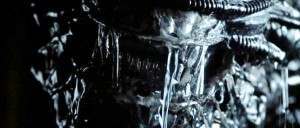
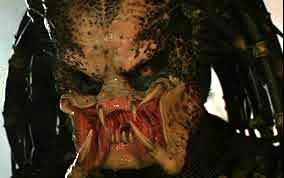
Predator (1987)
John McTiernan’s 1987 adventure/horror movie is actually part-Rambo (1985) and part-Aliens (1986), and is the best film on this list, by far. Still, much of its energy seems derived from the Alien aesthetic.
Here, we get the remote location (a jungle in Central America instead of outer space), an alien — with a similarly distinctive jaw-line — that cuts down one human at a time, and is a kind of alpha or apex predator.
The alien in Scott’s film was the ultimate survivor, able to breed and survive in any setting. The alien, by contrast, in Predator is the universe’s greatest hunter, a characterization that sets up a conflict with planet Earth’s greatest warrior, Dutch, played by Arnold Schwarzenegger.
But the real commonality between Alien and Predator arises in a mid-story surprise and revelation of conspiracy. In Alien, the Nostromo’s science officer, Ash (Ian Holm), protects the alien all along, and considers the rest of the human crew “expendable,” on secret orders from the Company.
In Predator, Dillon (Carl Weathers), an ambitious military officer, uses the cover of a rescue mission to get Dutch’s men into a position where they can acquire important documents about “the enemy.” As in Alien, the soldiers serving under Dutch are thus considered “expendable.”
Neither Ripley nor Dutch respond well when they expose the secret conspiracy, and the conspirator. In Predator, however, Dillon gets a shot at redemption, and Ash gets…decapitated.
Posted: 7th, June 2014 | In: Film, Flashback, Key Posts | Comments (2)
Peter Tork’s Dairy Erotica On Acid: A Look Inside The March 1971 ‘TEEN magazine

THERE’S no better insight into the teenage girl psyche than those ubiquitous teen magazines. So, let’s step into the mind of early Seventies teenyboppers and take a look at the March 1971 issue of ‘TEEN magazine. It’s chock full groovy advertising and advice, fashion and feminine hygiene. Within its glorious pages we’ll find a plethora of mini-skirts, a cry for the whereabouts of Peter Tork, and how to look fabulous in the jungles of Vietnam. Come take a look!
DYE ADVERT – MAY CAUSE ACID FLASHBACK
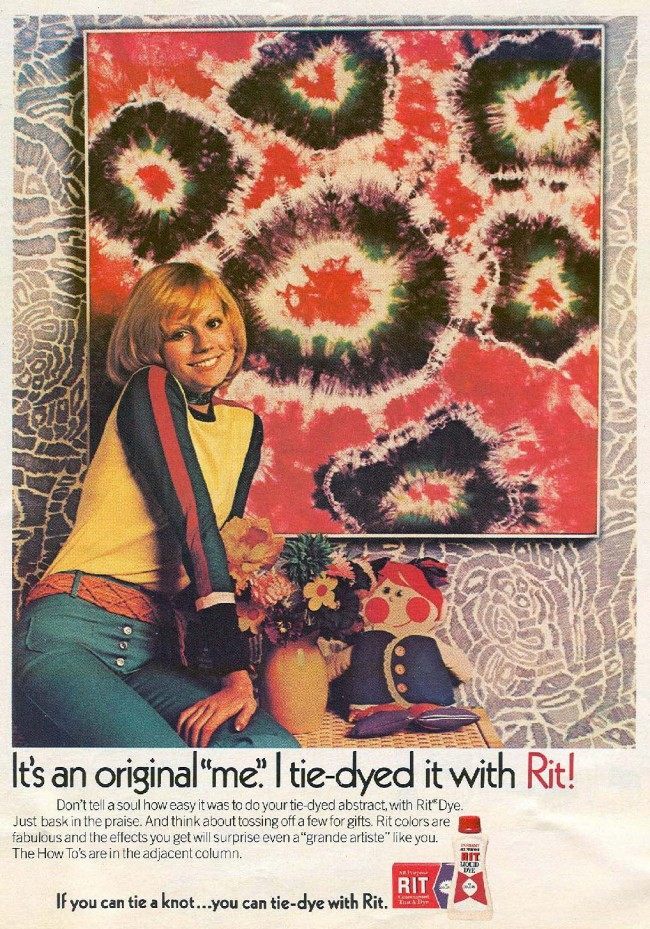
This tie-dye painting in combination with that wallpaper is causing a bit of a sensory overload. While I’m sure that wall is nice while gobbling up psychedelics, it would be migraine inducing on a daily basis.
Read the rest of this entry »
Posted: 6th, June 2014 | In: Books, Flashback, Key Posts, The Consumer | Comments (2)
Mic Wright’s Remotely Furious: The Secret Life of Babies Beat The Boring Days of BA
Mic Wright’s Remotely Furious: The Secret Life of Babies beat the boring days of BA
I NEARLY skipped The Secret Life of Babies on ITV this week for fear that it could never life up to the greatest documentary on the inner-workings of the baby mind: Rugrats. While the makers of The Secret Life of Babies failed to catch any of their subjects talking or tumbling around on quests, they did reveal a lot most of us probably didn’t know about the bouncing little bundles of joy. One of the most striking scenes was the moment when a baby looked on utterly unperturbed as a leopard pounced at the reinforced glass dividing them. Plants, on the other hand, are babies natural nemeses. The theory is that infants are naturally adverse to foliage in case its poisonous. Quite why nature didn’t instil them with a fear of sharp teeth remain unexplained.
Read the rest of this entry »
Posted: 6th, June 2014 | In: Key Posts, TV & Radio | Comment
Vet Shot Zoo Worker Pretending To Be An Escaped Gorilla
IN preparation for the event of a gorilla escaping from Tenerife’s Loro Parque Zoo, a man pretended to be an escaped primate. He was spotted by a vet who shot the man in the furry suit with a tranquilliser dart containing enough medicine to down a 450lb gorilla.
The shot man, a 35-year-old zoo worker, was taken to the University Hospital of the Canary Islands.
Read the rest of this entry »
Posted: 5th, June 2014 | In: Key Posts, Strange But True | Comment (1)
From Soup Tins To Dog Turds – How Life Got ‘Iconic’
THE England squad has departed to Miami for warm-up games en route to the World Cup finals in Brazil.
Or should that be ‘the England squad has embarked upon its iconic journey to Miami…’?
![]()
A recent ‘survey’ conducted among passengers at Heathrow Airport sought to find ‘the top 10 iconic departures that resulted in sporting history’.
The winner, should you happen to be interested, was Sir Ranulph Fiennes flying to conquer Everest and cross both polar ice caps in 2009. The runner-up was Andy Murray flying to America to win the 2012 US Open.
Leaving aside the preposterously tenuous nature of the concept – the plane trip that preceded the historic achievements – one thing in particular stands out: the word ‘iconic’ itself.
Read the rest of this entry »
16 Tragic Science Fiction Calendar Miscalculations
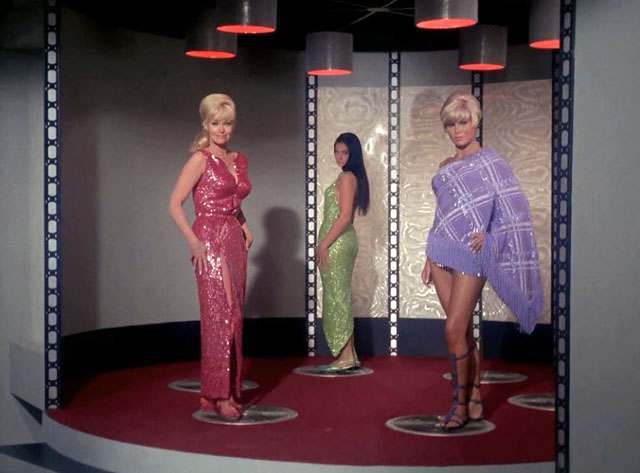
THE phrase “Where’s my jetpack?” has become something of a collective outcry in recent years. Since the 1950s, we’ve been indoctrinated with visions of the future full of spaceships, time travel, instant food, laser guns, and best of all, dazzling sci-fi duds.
Instead, here we are in 2014 and things haven’t shaped up to that Utopian model at all. Sure, communication technologies have exceeded our expectations, but the “Jetsons” lifestyle still hasn’t arrived. Thanks to pop culture’s broken promises of delivering robot maids and whooshing Star Trek doors in a timely manner, we are all a little disappointed.
Here’s a list of sci-fi TV shows and movies and the dates they were supposed to take place. Some are reasonable… some way, way off the mark.
1. LAND OF THE GIANTS
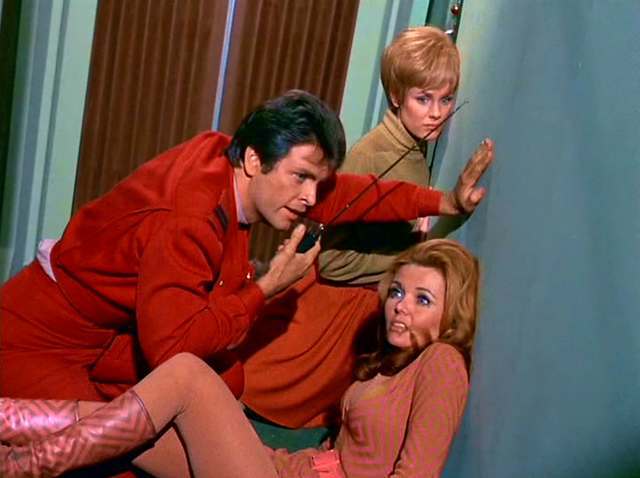
Land of the Giants is set in 1983. This is one of the more blatant errors in calculation. Fancy tourist spaceships are still nowhere in sight, and we’re 31 years past the show’s setting.
2. UFO
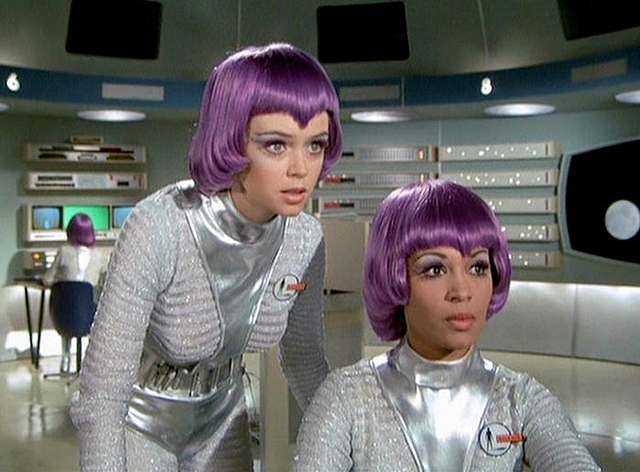
The TV series UFO. was actually set in 1980. As you will recall, the SHADO facility was one of the grooviest places on earth. Everything was painted mod colors with babes in mini-skirts or unitards strolling the hallways… and there was Moonbase. Well, it’s 34 years past due, and still no purple haired Moonmaidens.
3. SPACE:1999

Anyone who watched Space:1999 knows the show should’ve been called Space:1976. Evidently, earth-toned velour track suits were in vogue on Moonbase Alpha.
4. LOGAN’S RUN
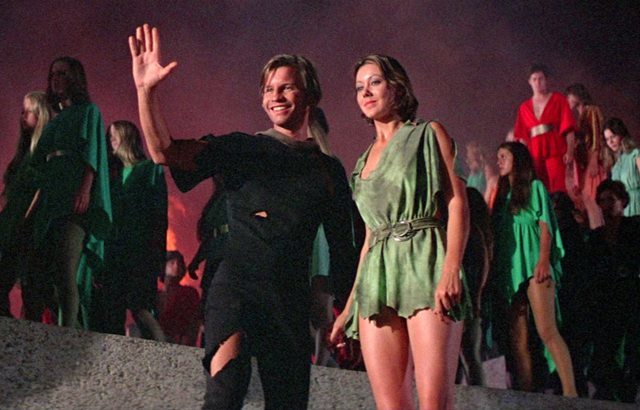
Logan’s Run is set in 2274. Even though it features teleportation devices, I guess it’s far enough away in time that I can go along with it.
5. BLADE RUNNER
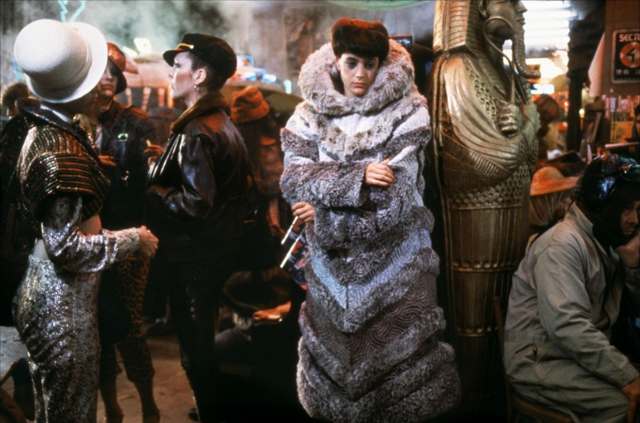
Blade Runner is set in 2019. We officially have five years to go before we have to start worrying about those pesky replicants.
6. TOTAL RECALL
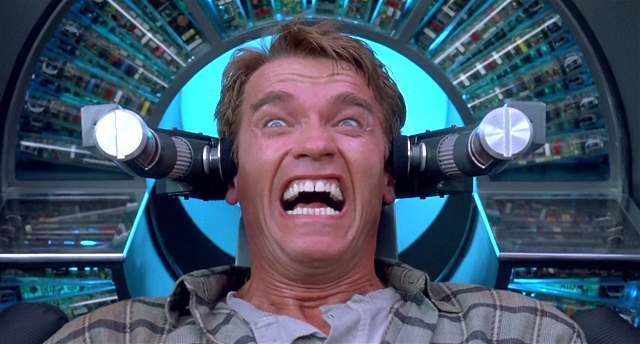
The year is 2084 in Total Recall. I was kind of hoping that virtual reality thing would come around a bit sooner. Although, the three-breasted mutant women and cars driven by Howdy Doody robots can wait.
7. FORBIDDEN PLANET

Forbidden Planet is set in the early 2200s. Can we reasonably expect interplanetary travel and Robbie the Robot in a couple hundred years? The “plastic educator”, a device capable of measuring and enhancing intellectual capacity, seems doable.
8. THE JETSONS
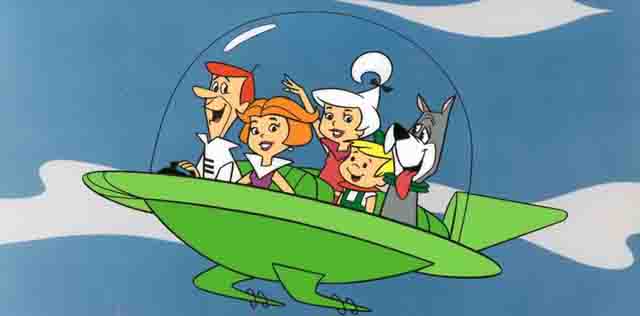
The original Jetsons was supposed to take place in 2062. If I could pick any science fiction universe to live in, it would be The Jetsons, without hesitation. Sure, you still had to work and deal with overbearing bosses (Mr. Spacely was a dick!), but it was more than compensated by the Utopian awesomeness of it all.
9. PLANET OF THE APES

The crew in Planet of the Apes left earth in 2006 in their spaceship traveling at near light speed. Spoiler alert: They crash landed on Earth in the year 3978.
10. ESCAPE FROM NEW YORK
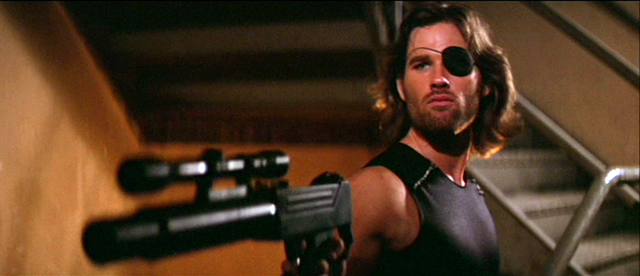
The tag line for Escape from New York:
The year is 1997. The Big Apple is the world’s largest penitentiary. Breaking out is impossible. Breaking IN is INSANE.
11. METROPOLIS
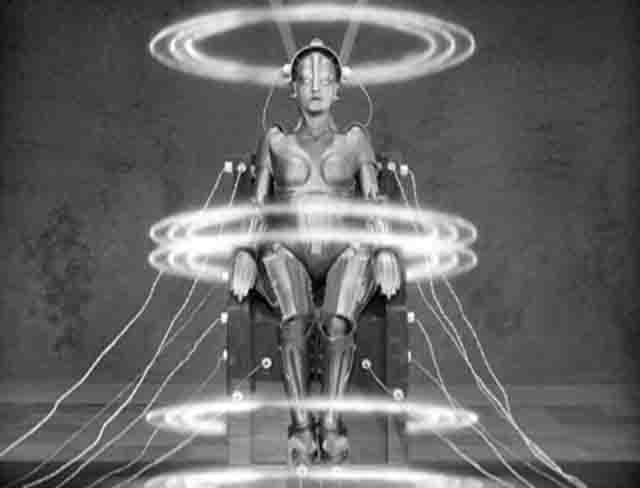
The 1927 film Metropolis is set in 2026.
12. 2001: A SPACE ODYSSEY
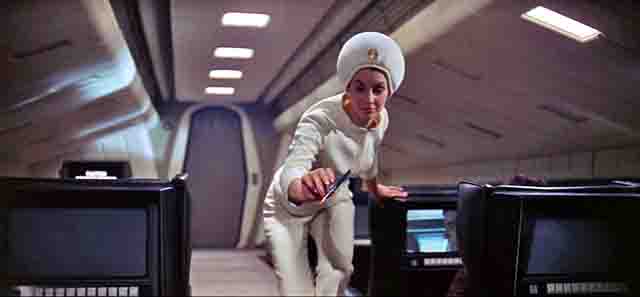
2001: A Space Odyssey was right on the money for a lot of things, but it overshot its wad on artificial intelligence and suspended animation.
13. ALIEN
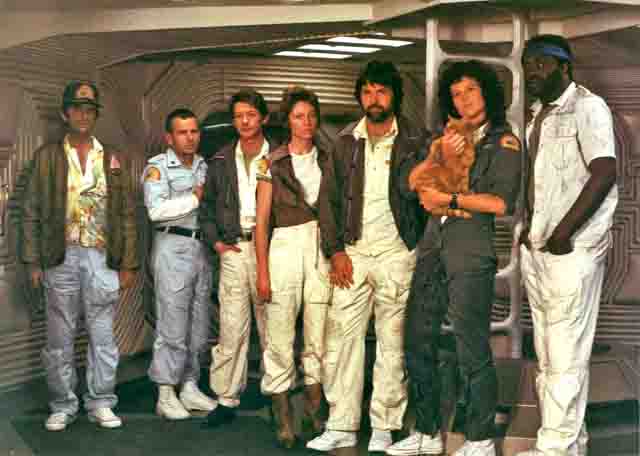
Alien is set in 2122. Again, filmmakers have a tendency to underestimate the time it will take to develop this suspended animation thing. It’s the only feasible way to have interstellar space travel, so I understand their motives.
14. BUCK ROGERS IN THE 25TH CENTURY
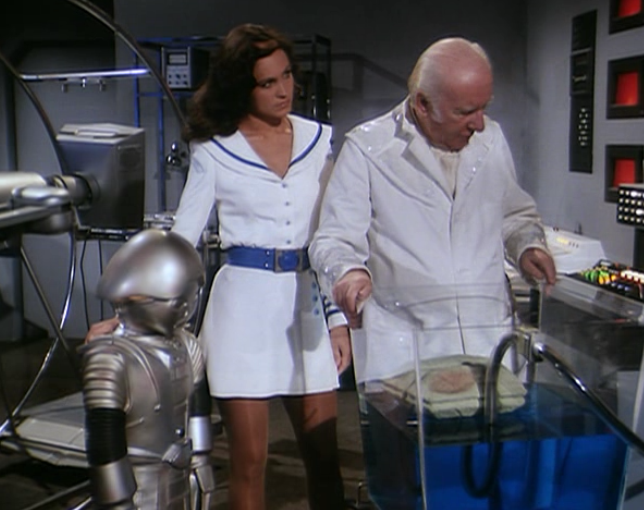
The Buck Rogers TV series is set in 2491. This show was overflowing with sci-fi tropes: lasers, spaceships, groovy fashions, and wisecracking robots. Since it’s still 477 years away, I’ll give it the benefit of the doubt.
15. BACK TO THE FUTURE II

Back to the Future II is set in 2015. Only one more year until the hoverboard!
16. STAR TREK
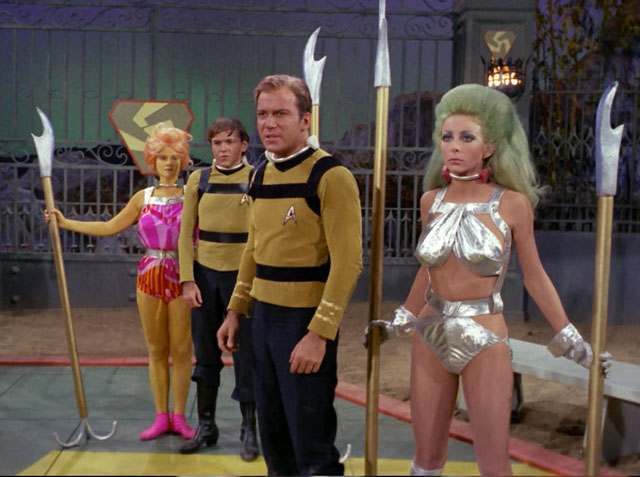
The best method to avoid having your film or TV show woefully outdated may be to set it far beyond the present date like Dune, which is set thousands of years ahead. Or, opt for the Star Wars plan and have it set a long time ago in a galaxy far, far away. But the best plan of all may have been Star Trek which used “Star Dates”, which kept the timeline purposefully ambiguous.
Sadly, that was all ruined by Star Trek: The Next Generation which was set in 2364, which allows us to extrapolate that the original series was about 100 years prior. This really blows the mystique and pisses me off…. what say you, Dr. Bones?
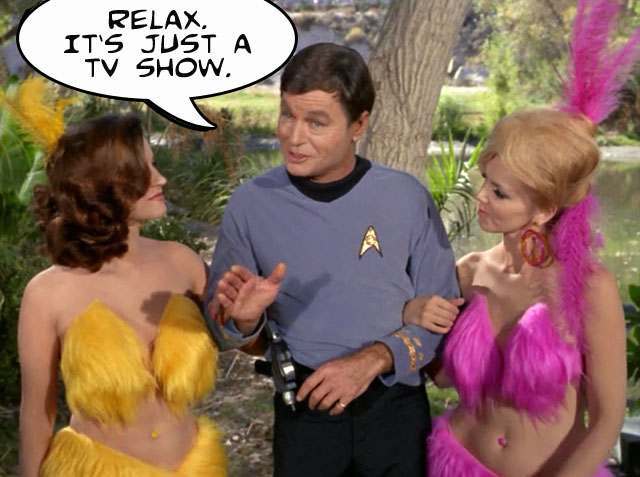
Posted: 3rd, June 2014 | In: Film, Flashback, Key Posts, TV & Radio | Comments (10)



